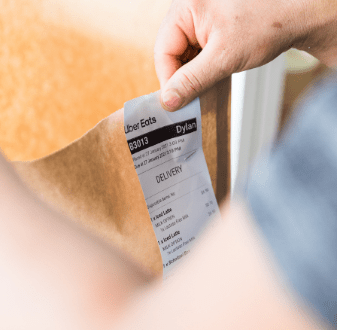Three of the world’s biggest delivery service apps: Uber Eats, Deliveroo and DoorDash, reported a massive acceleration in usage within the first few months of lockdowns in the US.
Restaurants that may never have previously considered offering delivery turned to apps like UberEats in order to stay afloat. In Australia, the food delivery service industry grew by AUD $2 billion in 2020 alone. Today, 73% of Australian millennials place their food orders through food delivery apps.
Delivery apps are increasingly essential to business, and not just because of the considerable customer reach and marketing opportunities they offer.
Food delivery apps are here to stay
Since 2017, the total value of the global restaurant delivery market has tripled, now sitting at a whopping AUD $218 billion.
However, just because COVID-19 lockdowns have largely come to an end, this doesn’t mean food delivery industry growth is going to slow in any meaningful way. In fact, 2022 growth projections show that the value of the global industry will reach AUD $465 billion by 2029.
What may have started out as a COVID-19 boom in app delivery options has now become the new normal. With the development of new in-app analytics tools and dashboards for restaurant management, these platforms have transformed from simple digital ordering tools to sophisticated machine-learning based data analytics service providers.
What is Uber Eats Restaurant Manager?
The Uber Eats Restaurant Manager is an analytics dashboard service for restaurant merchants who sell orders to customers via the Uber Eats app. Merchants can use this dashboard to harness Uber Eats customer and purchasing data to improve both their business on the Uber Eats app, as well as in-house.
The dashboard extracts data and translates it into clear, actionable information in the form of charts, categories and graphics that a restaurant owner can easily use. It offers this data across twelve categories:
- Your sales in a given period
- Your order volume
- Top selling items
- Your busiest hours
- Average ticket size
- Missed orders
- Inaccurate orders
- Menu item feedback and ratings
- Restaurant handoff rating
- Restaurant rating
- Restaurant rating by courier partners
- Restaurant downtime
How Uber Eats Restaurant Manager works
By keeping track of the data presented across the Uber Eats Restaurant Manager categories, restaurants can track customer feedback, the performance of products and other data essential to improving their business.
The dashboard categories can then use this data to help a business pinpoint missed opportunities for sales:
- The ‘restaurant downtime’ category allows the merchant to see when customers perceive the restaurant to be closed even if it’s open, and to correct this missed opportunity by increasing their activity online.
- By tracking ‘missed orders’ you can see if you need to adjust your service or respond to customer orders more quickly.
- Keeping track of ‘inaccurate orders’ allows you to identify potential revenue losses through refunds.
Through monitoring ratings and reviews on the Uber Eats Restaurant Manager dashboard, restaurants can also take advantage of anonymous customer feedback to improve their product or service. The analytics platform facilitates personalised advertising based on data, integrated social media promotions, as well as targeted promotions to bring in revenue and attract new customers.
The restaurant can also engage directly with customers on the platform in order to create dialogue and potentially repair any damage to the customer relationship resulting from issues.
The restaurant can also use the platform to conduct market research. By digging into data on customer preferences, top selling items, busy periods or seasonal preferences, the merchant can develop new food items that cater more specifically to their customer’s tastes.
Uber Eats Restaurant Manager and food delivery app data analytics services
With the proliferation of big data and machine learning powered delivery apps, every order, rating and review leaves a trail of important data that can be captured and analysed in real time, for the benefit of restaurant businesses and ultimately consumers.
Uber Eats Restaurant Manager is just one example of a delivery app now providing a data analytics dashboard service to restaurants.
Deliveroo also has their own version: the Deliveroo Restaurant Hub, where merchants can track data on orders and sales, read customer reviews and ratings, or offer special promotions.
Similarly, food delivery start-up Blink offers a dashboard to restaurants allowing them to benefit from data-driven results and make decisions based on metrics. Their platform facilitates integrated social media marketing campaigns, loyalty programs, and other strategic offerings that rely on the collection of customer data.
Beyond the very real benefit of providing direct access to a broad customer base (albeit with a percentage fee), delivery platforms have gone a step further in their offering to restaurants. They now facilitate the collection and utilisation of data that a restaurant would simply not be able to access were they only relying on feedback from diners in-house.
From ensuring on-time delivery to personalised orders and immediate customer feedback, the function of food delivery apps in 2022 has gone well beyond taking a simple order:
- Grubhub analyses ordering patterns to identify consumer trends and behaviour for personalised service.
- Sprig anticipates customer orders in each locale before they are placed, leading to reduced delivery times.
- DoorDash uses data to plot variables like time of the day and stock inventory, to predict the expected demand and food preparation time.
- Just Eat uses data to predict what kind of cuisines are likely to be ordered at a specific time, according to each customer.
For any restaurant thinking strategically about the future, incorporating delivery apps and the data analytics dashboards they offer into your business plan is an absolute must this year and beyond.
Thinking about a career in hospitality?
If you can see yourself a leader in the hospitality industry, you need to make sure you’re equipped with all the right skills for your business to succeed. An ideal place to start your training is with a Bachelor of Business (Hospitality Management) at Torrens University Australia.
This flexible and broad degree covers every key area you need to know to lead hotels, restaurants, tourism operators or any other hospitality business into the future.
The course mixes hands-on learning with practical know how, industry placements, and essential theory in business, finance and marketing. Core subjects include:
- Marketing Fundamentals
- Exploring Gastronomy
- Front Office Operations
- Tourism, Hospitality and Events
- Accounting for Decision Making
- Global Innovation and Trends in Tourism and Hospitality
- Product Distribution and Revenue Management




